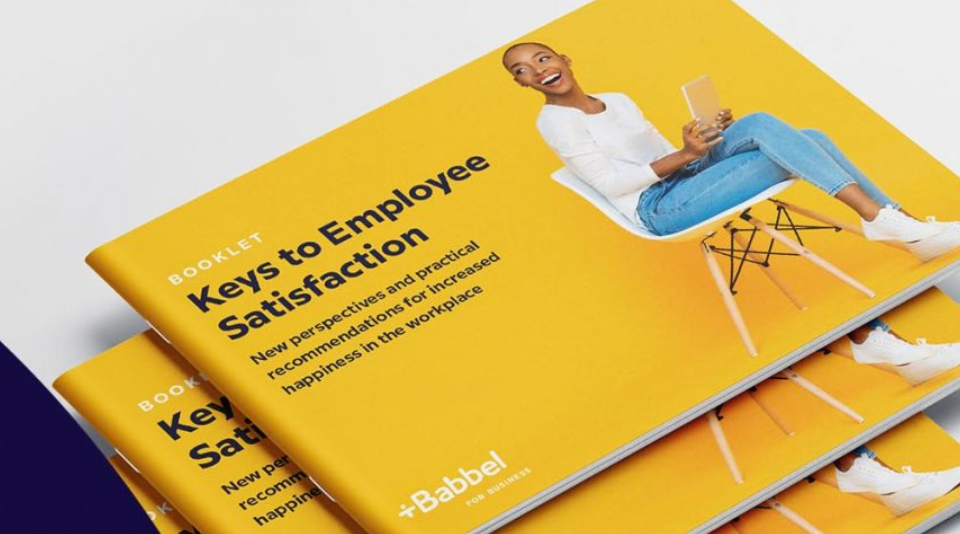In this post, we show you how you can contribute to increasing employee satisfaction in your business, why material incentives for motivation don’t last – and which benefits are the most effective.
Employee happiness, recruiting, team loyalty – only those who truly invest in their employees’ satisfaction will meet the challenges of the future: globalization, skilled labor shortage, digitalization. In a world that grows ever more mobile and networked, it’s crucial to develop new and sustainable strategies. After all, those who are happy to go to work truly give their best.
So how can you increase employee satisfaction in your business? First it’s key to put all options on the table, and then, together with your team, take the next steps toward a positive corporate culture – for more employee happiness, yes, but also for increased success for your company. It’s possible that the first things that come to mind are tangible benefits such as a company car or ping pong table, but this is a common error. We’re not actually talking about material goods here – instead, you should be recognizing the individual potential of your employees. And, thanks to digital tools, this is possible to do in a work-from-home situation, despite the coronavirus pandemic. The following 10 tips will help you to support your employees, for more satisfaction in the workplace.

Would you like your employees to be happier and more motivated at work? Then download our new booklet, “The Path to Employee Satisfaction.”
1) A positive work environment
The most important requirement for more satisfaction in the workplace? Appreciation for your employees’ work. After all, when workers are valued and accepted, this feeling of satisfaction influences the entire corporate atmosphere – and a respectful and trusting team relationship is the foundation for this.
To this end, an additional position of Happiness Manager can ensure that there’s a dedicated contact person for the concerns and issues facing your team, because monitoring employee satisfaction is important for the sustainable success of your business. Regular feedback conversations or surveys also offer employees the opportunity to make themselves heard if any problems arise.
2) Few stressful situations
One of the most important elements of increased employee satisfaction: time. In most businesses, there’s just too little of it, whether it’s a too-short meeting before an important deadline or not enough unallocated time in the workday for unforeseen issues. Every now and then, stressful situations do pop up that require everyone to put in extra – but this should not be the everyday state of affairs. Introduce strategies to your team that save both time and nerves: email etiquette that doesn’t require the whole team be cc’d, or clear meeting agendas that result in clear goals. If we’ve learned anything from the coronavirus pandemic, then it’s this: That meeting probably could have been an email or phone call.
3) Sufficient downtime
Even before the pandemic, the subject of mental health was already important for a positive corporate culture. But lately, since most employees have been working from home, there has been almost no separation between work and life. But being constantly reachable comes at the cost of one’s concentration and creativity. Set firm boundaries as executives, and as a company: Don’t have a culture of returning emails at night, for example. This is the only way your employees can work at their full capacity – and do their jobs rested and happy.
4) Digital continuing education
Employee satisfaction is gaining more and more relevance. When it comes to the “war for talent,” businesses who wish to recruit and retain the best talent must enter the game with attractive benefits in learning and continuing education. But how to build the right continuing education program? It’s important to speak to the intrinsic motivations of your employees. In a two-way conversation, find out what sorts of new skills they would like to develop, and what your team needs to reach its full potential.
So what sort of professional development is the right fit? Digital learning has become an indispensable aspect of continuing education. Only those who are digitally fit can develop future-ready skills. The options for digital continuing education are many – would your employees like to learn something totally new, or build on skills they already have? With a language learning course from Babbel for Business, for example, you’d offer your employees not merely a practical tool that integrates digital learning into their day-to-day, but something that also promotes all-around skill-building – and makes for happy employees.

5) Sufficient time for learning
In order for your employees to truly pursue their new interests, you must create the right framework for success. An employee who already has time managing their workload will not be able to handle a language course on top of that, let alone come up with any ideas for professional development of their own accord. So create a culture in your business in which learning and professional development are an explicit goal. Provide your employees with sufficient time to work on themselves – not as extra duties in evenings or on weekends, but rather during the workday. The good thing about Babbel language learning programs in this context? They’re flexible and allow for short learning intervals. Empower your team with some self-determined learning opportunities, and you’ll be surprised to see how quickly they make enormous strides.
6) Extra budget for learning
In your company, plan in a specific budget for professional development of your employees, and trust that continuing education benefits are useful and practical for the whole organization. The good news? Digital learning programs are, on the whole, less expensive than in-person class, with the same outcome.
7) Inspiring mentorship programs
Role models are crucial. They offer inspiration and sharpen one’s own goals. Along these lines, a mentoring program can have a positive influence on your business. How about regular conversations between junior and senior employees? The more exchanges of ideas in your business – about goals and dreams, but also about concerns and issues – the more productive you can be toward creating a positive corporate culture.
8) Positive motivation
Review Maslow’s hierarchy of motivations: Only when an employee’s job is secure and their salary appropriate, can they even begin to think about further motivations or self-development. Once those needs are secure, activities such as an internal contest can help to motivate your team members. Set playful goals, and make sure it’s a low-pressure, low-stakes activity.
9) Dynamic team development
Do you find that your team is once again motivated, and wants to improve the team dynamic even further? With regular opportunities for team development, such as for example workshops or a weekend retreat, not only can you cultivate a productive sense of togetherness, you can also help prevent internal problems from arising.
10) Set a good example
It’s easy to make big plans. But only when you walk the walk – instead of just talking the talk – can your team members have both the trust and desire to work on bettering themselves. Just remember: if you offer your employees the opportunity for self-growth, you will reap the benefits of your labor: employees who are happy to go to work.
With Babbel for Business, you’ll have chosen a practical and productive online language learning program that both motivates and supports your employees. In our introductory booklet, “The Path to Employee Satisfaction”, we’ve compiled everything you need to know. Questions? Simply contact our team.





